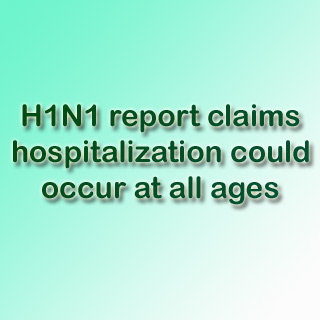
The authors mentioned that since April 17, 2009, when the first 2 cases of pandemic influenza A i.e. H1N1 virus infection were reported in California, the virus has rapidly spread throughout the world. They continued by stating that initial comparisons with seasonal influenza claim that this influenza infection excessively affects younger ages and supposedly causes commonly mild disease.
Janice K. Louie, M.D., M.P.H., of the California Department of Public Health, Richmond, Calif., and colleagues evaluated the medical and epidemiologic features of the first 1,088 hospitalized. They also examined lethal cases due to epidemic 2009 influenza A i.e. H1N1 infection accounted in California, between April 23 and August 11, 2009. On April 20 of this year the California Department of Public Health and 61 local health departments commenced superior scrutiny for hospitalized and deadly cases of this infection.
The experts discovered that of the 1,088 H1N1 cases, around 344 were children below 18 years, with infants supposedly having the maximum rate of hospitalization and individuals aged 50 years or older supposedly had the highest rate of death once hospitalized. 27 years was apparently the median age. Some of the common symptoms observed were fever, cough and shortness of breath. Basic conditions formerly linked to severe influenza were accounted in about 68 percent of cases. Further fundamental medical illnesses apparently comprised of obesity, hypertension, hyperlipidemia and gastrointestinal disease. Four days was said to be the median length of hospitalization among all cases.
It was seen that around 31 percent of cases were admitted to intensive care units, and of the 297 intensive care cases with accessible information, 65% needed mechanical ventilation. Of the 884 cases with obtainable information, around 79% were given antiviral treatment, counting 71% of patients with recognized threat issues for severe influenza. Of the 833 patients who suffered from chest radiographs, around 66% had infiltrates, indicative of pneumonia or severe respiratory distress syndrome. Rapid antigen tests were said to be incorrectly negative in about 34% of cases assessed.
The experts remarked, “Overall fatality was 11 percent (118/1,088) and was highest (18 percent – 20 percent) in persons aged 50 years or older. Of the deaths, 8 (7 percent) were children younger than 18 years. Among fatal cases, the median time from onset of symptoms to death was 12 days.”
The most prevalent causes of death were believed to be viral pneumonia and severe respiratory distress syndrome.
The authors quoted, “In the first 16 weeks of the current pandemic, 2009 influenza A (H1N1) appears to be notably different from seasonal influenza, with fewer hospitalizations and fatalities occurring in elderly persons. In contrast with the common perception that pandemic 2009 influenza A (H1N1) infection causes only mild disease, hospitalization and death occurred at all ages, and up to 30 percent of hospitalized cases were severely ill. Most hospitalized cases had identifiable established risk factors; obesity may be a newly identified risk factor for fatal pandemic 2009 influenza A (H1N1) infection and merits further study.”
The authors concluded by mentioning that clinicians should maintain a high level of suspicion for pandemic 2009 influenza A (H1N1) infection in patients presenting currently with influenza-like illness who are older than 50 years or have known risk factors for influenza complications, regardless of rapid test results. Hospitalized infected cases should be carefully monitored and treated promptly with antiviral agents.
The study was published in JAMA.
